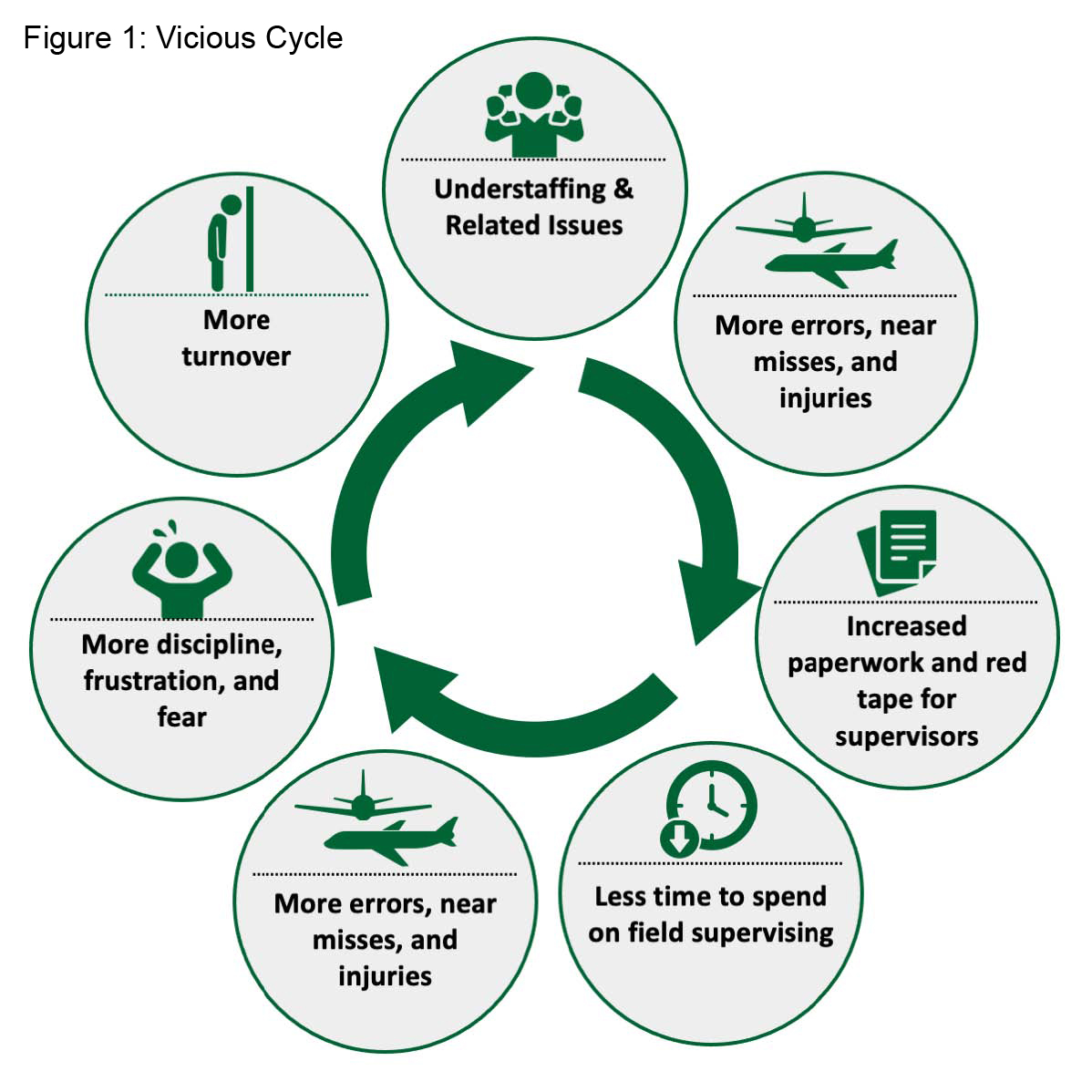Running Too Lean: Turnover and Vicious Cycles Threatening Safety Performance
Turnover rates have climbed over the last two decades, with occasional periods of stability and fluctuation across different sectors. However, since 2019, most industries worldwide have experienced a sustained and pronounced rise in the trend. Projections indicate that this pattern will probably continue through 2024 and beyond.
While the specific reasons for the escalation vary—including cost-cutting measures, work-life balance concerns, and values misalignment between employees and employers—how it impacts the workforce, and in particular how it impacts safety, shows striking similarities across most high-hazard industries we consult in.
This article examines turnover not as a standalone problem but as a challenge within an interconnected system. It proposes strategies that consider the entire network, emphasizing the need for a holistic approach to lessen the effects of running too lean.
Open Systems
Organizations are open systems. Open systems receive inputs and resources from the environment, which are then processed to produce outputs. A defining characteristic of open systems is that their components are interconnected and tightly networked. Disrupting any one element can cause a cascade of effects that impact the entire system. Anyone who has worked in an organization understands the high level of interdependence between departments. They also understand the disorder that can occur when the balance is upset. When one element in the system falters, the disruption can snowball, affecting multiple departments and the overall efficiency of the entire company.
Safety and Running Too Lean
Based on our investigation of organizational cultures across six continents, we've noticed common patterns in how turnover and understaffing affect various sectors. The workforce is usually candid about their frustration, so stating that it causes employee complaints is not breaking news.
 The more alarming revelation emerges when running too lean is viewed from a more holistic and cultural perspective. Like a virus in a body, understaffing problems spread from one interconnected organizational system to another–causing cross-departmental disruptions in morale, budgets, workflows, systems, and safety performance.
The more alarming revelation emerges when running too lean is viewed from a more holistic and cultural perspective. Like a virus in a body, understaffing problems spread from one interconnected organizational system to another–causing cross-departmental disruptions in morale, budgets, workflows, systems, and safety performance.
While short staffing affects various aspects of an organization, the main repercussions we've encountered can be bucketed into three overlapping categories: (1) Safety Systems; (2) Morale and Job Satisfaction; and (3) Training, Development, and Competence.
Safety Systems
Understaffing can severely hamper the effectiveness of safety systems. An employee's time is not a limitless resource. When a significantly understaffed organization fails to adjust production plans, manage the number of initiatives, and/or reduce administrative responsibilities, it risks spreading the workforce and leadership teams too thin.
While there may be several reasons for a decline in safety system performance, it is among the most critical indicators of high turnover. Here are some common signs that understaffing is having a negative impact:
Safety Work Order Turnaround Time: Understaffed organizations often struggle to keep up with the volume of work orders. The teams responsible for addressing employee reports on hazards simply don't have the resources to respond consistently or in a timely manner. When employees’ reports of safety issues are perceived as being ignored or significantly delayed, not only do hazards remain unaddressed, but employees trust in management and the importance of safety are undermined. This can discourage them from turning in hazard requests and produce a general disengagement from safety initiatives.
Consistency of Inspections: Essential inspections for maintenance, electrical, and process safety are often delayed due to a lack of personnel. This increases the likelihood of safety incidents and regulatory noncompliance issues. Additionally, the workforce can view such delays as a very public and visual erosion of operational discipline and safety culture values.
- Near Miss Reporting: Understaffed companies often see a decline in Near Miss reporting. Employees may feel like they don’t have time to report incidents or that it's pointless to report due to inaction on previous reports, caused by insufficient personnel. This decline can result in potential hazards remaining unidentified and critical learnings not being communicated.
Supervisor Time in the Field: Leadership presence in the field—especially that of frontline supervisors—is critical for fostering a safe culture. Consistent, high-quality interactions between supervisors and employees are essential for developing safe habits across the workforce.
These leadership interactions should focus on instilling the values of safe production, identifying potential hazards, removing obstacles, providing resources, offering coaching and direction, and reinforcing safe behavior. The less this occurs, the less influence the organization has in steering the culture in the right direction.
Supervisors are accountable for various daily activities. Their time might include attending multiple meetings, handling administrative duties, managing schedules and shifts, addressing grievances, onboarding new employees, managing budgets and resources, and spending time with their workforce. Even in a well-staffed organization, this is a full schedule. When running too lean, supervisors must prioritize their tasks even more strictly. Unfortunately, this often means sacrificing their time in the field—the very place where their presence has the most significant impact on maintaining safety and quality standards.
Increased Pencil Whipping: Superficial compliance, or "pencil whipping," occurs when appearing to meet safety standards is prioritized over genuine safety participation.
In many understaffed and overwhelmed organizations, management often shifts from fostering meaningful safety practices to auditing quotas. This is understandable. For example, simply checking the number of safety interactions is quicker and easier than engaging in meaningful coaching with employees about their safe practices, especially when time and resources are limited.
Unfortunately, this shift changes the performer's focus from ensuring quality performance to merely "hitting their numbers." There is a significant difference between a manager asking a supervisor, "How many safety interactions did you do this week?" and asking, "What was the most important safe behavior you observed this week, and how did the employee respond to your feedback?"
The former emphasizes meeting quotas, while the latter underscores the value and purpose of safety interactions and employee development. It also creates positive accountability for coaching.
If leaders consistently inquire about performance quality, they will get quality. Conversely, if they only inquire about quantity, they will encourage meeting the numbers in the most expedient way possible–which is often pencil whipping.
Morale and Job Satisfaction
Employee morale and job satisfaction permeate every aspect of organizational performance, including the turnover rate itself.
Understaffing impacts morale and job satisfaction in the following ways:
Frustration and Erosion of Trust: Most people take pride in their work, and their performance is closely tied to their morale and sense of fulfillment. When employees lack the resources to meet expectations, their frustration can affect their morale and relationship with management.
When it comes to safety, running lean is sometimes perceived, rightly or wrongly, as a sign of management neglect. Employees may feel that safety is not a priority for their leaders if they believe they're "allowing this to happen."
At its most corrosive, this perception can lead employees to believe that management is willing to compromise their safety to save a few bucks. Even if this belief is wildly inaccurate, a perceived discrepancy between the stated value of safety and actual operational decisions can significantly erode trust and engagement.
- Exhaustion and Increased Stress: An employee's energy, like their time, has limits. Chronic understaffing often leads to an additional workload contributing to physical and mental fatigue. This can result in reduced focus, slower reaction times, diminished coordination, impaired judgment, and altered risk assessment–all of which considerably increase the likelihood of mistakes. According to the National Safety Council, "Fatigue contributes to approximately 13% of workplace injuries, significantly impacting both safety and productivity."
- Production Pressure: There are many sources of production pressure on employees. The most obvious source is from leaders. However, there are more subtle sources of pressure, even in organizations that continuously remind employees to take their time to perform safely. When employees feel like they are always behind, they may be tempted to cut corners to get back on track.
Training, Development, and Competence
Effective employee training is fundamental for maintaining safety and competence in high-hazard, complex work environments. However, when resources are overextended, these efforts can be significantly undermined, compromising worker readiness and overall safety.
The following points highlight key issues impacting training efforts when organizations are overextended:
- Less Effective Training Methods: Computer-based training (CBT) has become ubiquitous due to convenience and cost savings. While CBT can be effective, it is generally reported to be less effective than hands-on training. When organizations are short-staffed, pulling employees out for training and/or pairing employees up for on-the-job training often goes by the wayside. The impact of undertrained employees on safety is obvious.
- High Turnover and Shortened Training: High turnover rates often correlate with shortened training programs. The need for more resources in the field motivates the training to be completed at a faster pace than usual, compromising its effect on skill development. This can result in workers engaging in complex and hazardous tasks they may not be ready for.
- Time to Productivity and Extra Support: It can take time for a new employee to become self-sufficient and productive, especially in complex and hazardous environments. Supervisors and peers must dedicate additional time and energy to support them alongside their responsibilities during this period. This contributes to the crew's short-staffing issues and adds a vicious cycle to the mix.
Vicious Cycles
A vicious cycle, also known as a self-amplifying loop, occurs when interconnected events influence each other in a looping sequence, worsening the original issue with each iteration.
These cycles often overlap across the previously discussed Safety Systems; Morale and Job Satisfaction; and Training, Development, and Competence. For an illustration, see Figure 1: Vicious Cycle.
Understanding these patterns is crucial for leadership teams to identify their role in the loop and find ways to interrupt the cycle. In the next section, we will explore strategies to help break these cycles.
Ways to Minimize Effects of Running Too Lean
Many organizations have done their due diligence and conducted formal assessments to identify their optimal staffing levels. However, filling these gaps with the right people will take time. While working towards ideal workforce size, organizations have to address the challenges of operating with lean teams.
This section presents some strategies that can minimize the challenges associated with understaffing, as well as serve as general best practices in support of safe production.
- Prioritize Supervisor Field Time and Coaching: Supervisor field time and coaching are essential in dealing with the pressure created by understaffing. Supervisors can reinforce the message that meeting production deadlines is not worth risking lives. This becomes especially critical with a high number of overwhelmed or new employees. To facilitate this critical activity, minimize the less impactful paperwork and meetings to create more time for supervisors to be present in the field.
- Focus on the Critical Few: Identify the most essential and impactful safety activities. Avoid overwhelming employees with too many administrative tasks and non-value-added paperwork. Create tight, positive accountability for critical activities. For example:
- Leaders should prioritize meaningful engagement and the quality of safety interactions over mere numerical targets. Quotas are not inherently bad, but problems arise when the emphasis is solely on meeting the numbers rather than the quality of interactions. Maintain leadership conversations mostly focused on quality.
- Focus on SIF-related issues by conducting frequent observations and providing feedback.
- Ensure engaging and effective pre-shift meetings, with managers observing and giving feedback.
- Dedicate time to coaching performers on critical safety protocols like pre-task hazard assessments and LOTO procedures.
- Ensure Observations of Work Occur: Observe important safety behaviors directly through peer and supervisory observations. Incorporate quality, positive coaching interactions during these observations, providing frequent feedback and reinforcement for critical safety behaviors. Respond diligently to unsafe conditions and near misses.
- Enhance Hazard Response and Feedback Systems: Promptly addressing unsafe conditions, near misses, and hazard reports is essential for fostering a safe culture. Removing hazards can markedly decrease the likelihood of an incident and boost employee safety engagement. Improving feedback systems to keep employees informed on hazard status and resolution demonstrates that their concerns are heard and valued, encouraging continued reporting and active participation in safety initiatives.
Conclusion
Employee performance is, in great part, a direct response to leadership decisions. Understanding this critical role from a systemic perspective allows leaders to recognize the far-reaching impact of their choices. This awareness is essential for:
- Predicting and interrupting vicious cycles before they escalate
- Making proactive decisions with long-term benefits
- Addressing complex, system-wide issues like turnover
- Avoiding or course-correcting leadership choices that compromise performance
The key lies in connecting the dots between leadership actions and their cascading effects across the organization. Leaders who grasp the interconnected nature of organizational systems are better equipped to make strategic decisions that benefit the entire enterprise.
Click here to read more about the author, Francisco Gomez.




